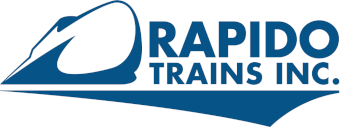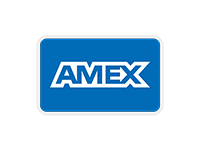By Alex Stroshane
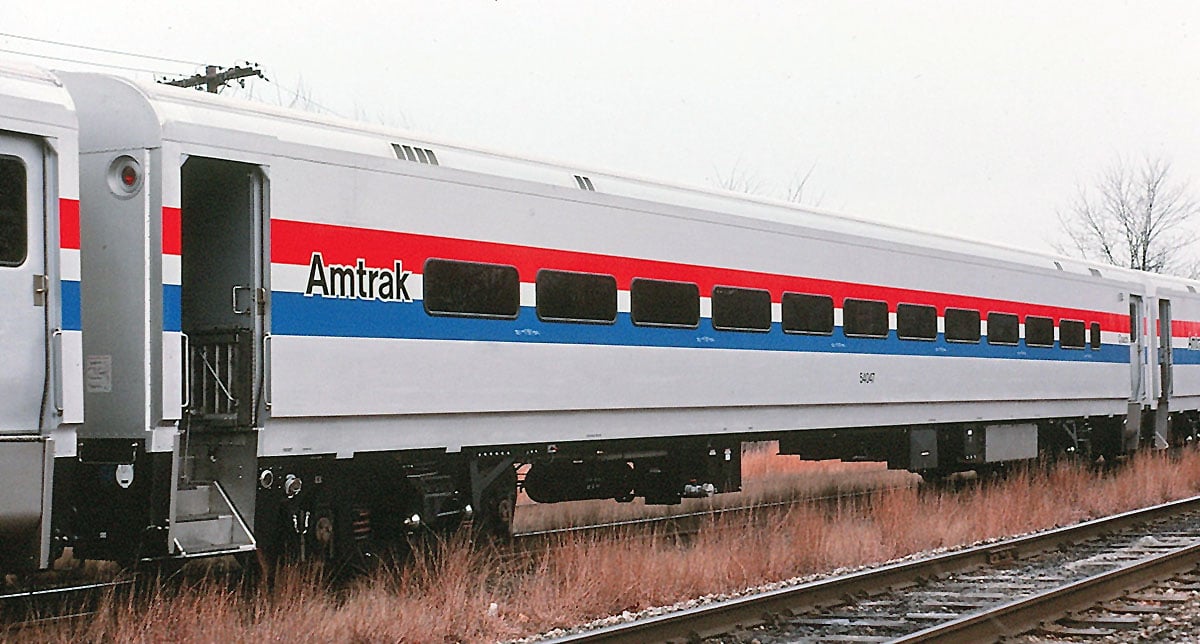
Horizon Fleet coach 54047 is seen while being delivered from the Bombardier plant in Barre, VT. Rolf H Schneider photo, Corey Fischer collection.
A Growing Railroad
When Amtrak was formed in 1971, it inherited a massive fleet of streamlined, steam-heated passenger cars from the railroads whose passenger operations it took over. Many of these were already several decades old, and aside from the all-stainless steel Budd cars, were in rapidly worsening condition. To operate its short-haul routes with more reliable equipment, Amtrak ordered 492 Amfleet I coach and food service cars from Budd, which were delivered in 1975-1977. These cars relied on head-end power (HEP) rather than steam heat, necessitating the purchase of new locomotives like the P30CH and F40PH. At the same time, Amtrak began converting some of the older Budd streamliners to HEP so that it could use a mix of equipment for longer-distance trains. This was followed by an additional order of Amfleet II coach and lounge cars from Budd, built from 1981-1983. With their single vestibules, the Amfleet II fleet was intended to operate only on long-distance trains, which freed up some of the Amfleet I cars for expanding service on short-haul routes.
By the late 1980s, Amtrak was again in need of more cars that could be used on busy corridor routes, such as those radiating out from Chicago in the Midwest. Since Budd had just exited the railcar business – shortly after constructing three new Viewliner prototype body shells for Amtrak – a new supplier needed to be found. By this time, Bombardier had become a popular source for commuter cars built under license to a Pullman-Standard design, known as the Comet. By adapting this design to Amtrak’s requirements, they could quickly deliver the cars that were so desperately needed.
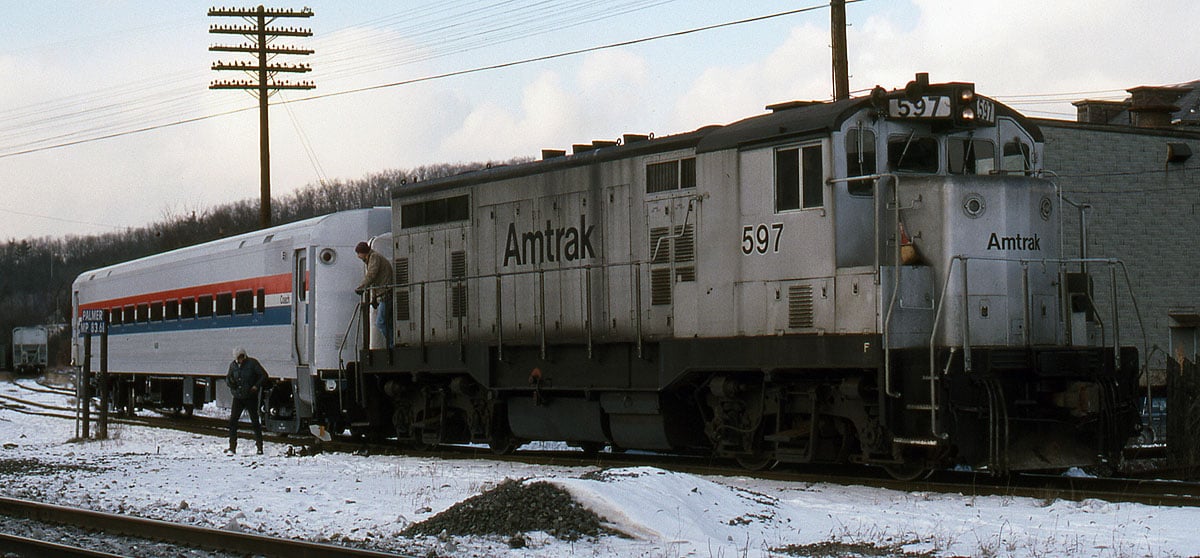
Amtrak CF7 597 picks up a brand-new Horizon coach from the Central Vermont interchange at Palmer, MA. Photo by Joe Snopek, collection of Alex Stroshane.
The Horizon Fleet
Although some early literature referred to the modified Comet design as the Amfleet III, it quickly became known as the Horizon Fleet. The coaches built for Amtrak featured much fewer seats than their commuter counterparts, carrying 68 to 82 passengers compared to as many as 131 in the Comet coaches. The difference was due to increased legroom, 2+2 seating instead of 3+2, and the inclusion of two restrooms. Some cars also included a small baggage area at one end, while others had a larger, wheelchair-accessible restroom.
Since food-service cars were also needed, the coach body was modified by blanking out some of the windows in the middle of the car and reducing the size of others. This created a small counter area where food could be heated and served. These cars were built in two configurations, both labeled Dinette on the outside, but tailored toward the type of routes they were to be used on. The full dinette cars included 12 tables with seating for 4 patrons each, while the snack-coaches contained 8 tables at one end and 19 coach seats at the other end. This arrangement was ideal for shorter routes, since it added some revenue space while keeping overall train length to a minimum.
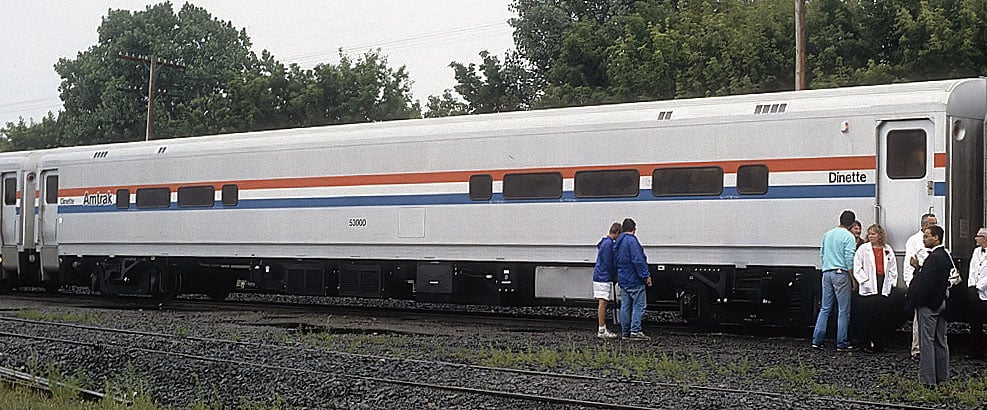
Members of the public check out brand-new Horizon Dinette car 53000. Photo by Marty Bernard, used with permission.
Amtrak-Specific Features
Apart from the interior modifications, several other changes were made to the Comet design to make it more suitable for long-distance service:
- The inside-bearing General Steel Industries trucks were replaced by an outside-bearing version, the same type used originally on the Budd Metroliner MU cars, for improved operation at higher track speeds. These same trucks later found their way under the Superliner IIs, but with heavier springs due to the increased weight.
- The air-spring suspension was also changed to a coil-spring arrangement, visible on either side of the trucks between the bolster and the carbody.
- The automatic sliding vestibule doors of the commuter cars were changed to manual doors, and the low-platform steps were able to be folded up when not needed.
- The interior bulkhead doors at each end of the passenger compartment were powered to allow passengers easier access when moving between cars.
Ironically, the manual sliding doors and folding steps proved to be unreliable and unpopular with Amtrak crews, especially when packed with ice and snow during a Midwest winter. Gradually, as cars were shopped for maintenance, the doors were replaced by hinged Dutch doors and the steps were changed to a fixed design as on the commuter version. The new doors can be easily identified by their flat surface and smaller window, in addition to the visible split between the upper and lower hinged sections.
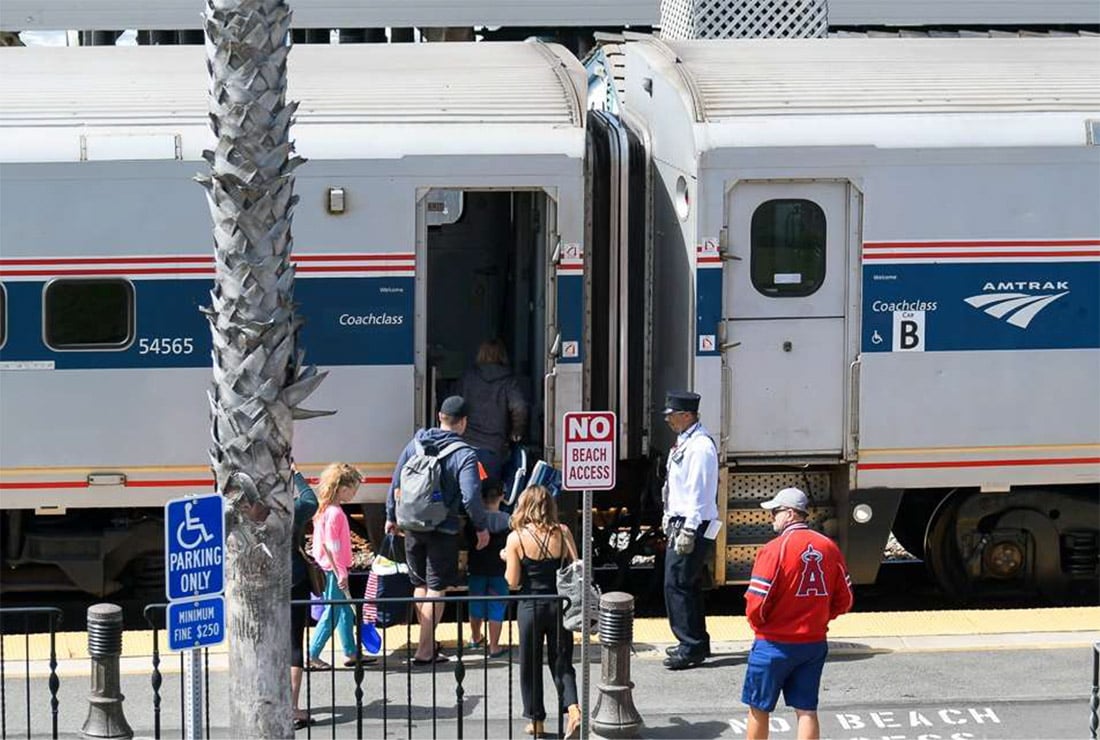
The sliding doors and folding step traps were eventually replaced by hinged Dutch doors and fixed steps, as seen here. Photo by Matt Donnelly, used with permission.
Paint Schemes
The Horizon cars have worn several paint schemes since being delivered. Interestingly, two different widths of the Phase III striping were applied to the cars when new. It’s not clear why this was changed, or if there was a cutoff date from one to the other. As the years have gone by, individual cars received updated stripes and lettering when they were shopped for maintenance, so the dates listed below are only approximate.
Beginning in 2013, three Horizon dinette cars were refurbished and leased to the state of California for use in San Joaquin service. They received new Amtrak California striping, lettering and individual car names. See the roster section at the end of this article for the car numbers and names.
Phase III, Narrow Stripes: 1989
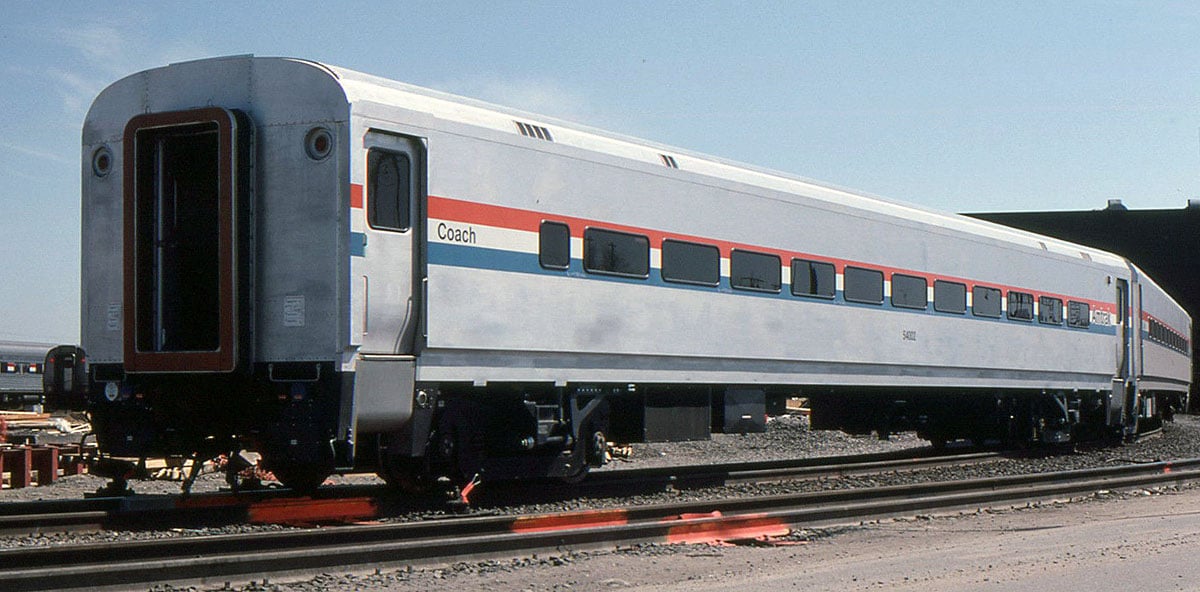
Coach 54002 is seen in Boston’s Southampton Yard shortly after delivery from Bombardier. Note the steps are folded up. Collection of Alex Stroshane, photographer unknown.
Phase III, Wide Stripes: 1989
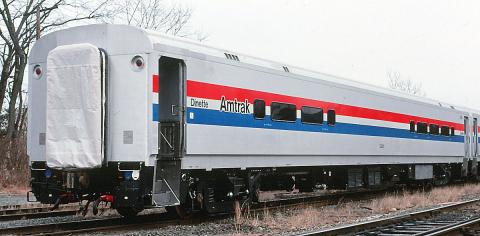
Dinette 53501 still has protective wrapping on its diaphragm while being delivered. In this view, the trap doors are open and the steps are folded down. Rolf H Schneider photo, Corey Fischer collection.
Phase IV: 1996 (approximate)
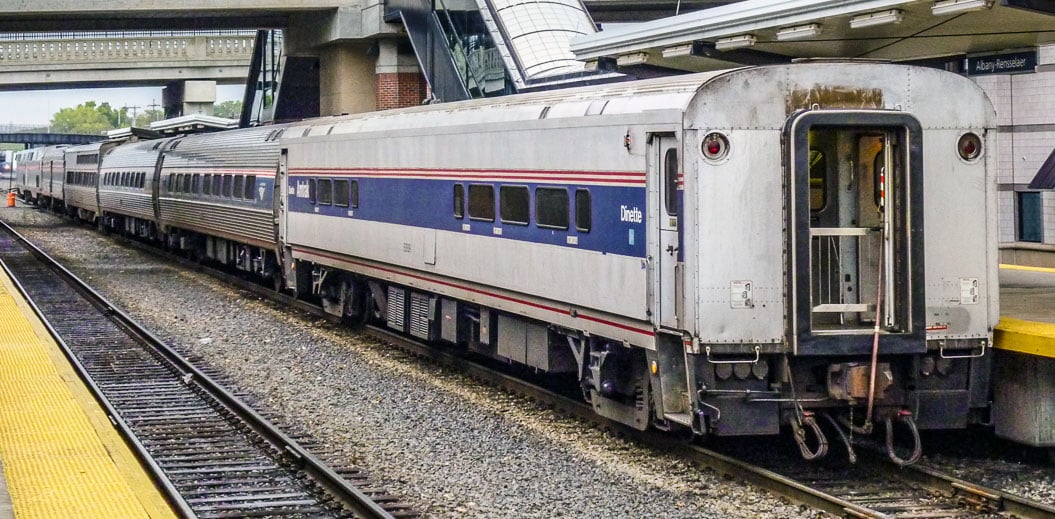
An unknown dinette brings up the rear of the Lake Shore Limited at Albany-Rensselaer, NY. By this time, the doors and steps had been replaced. Photo by Matt Donnelly, used with permission.
Phase VI (sometimes known as Phase IVb): 2002 (approximate)
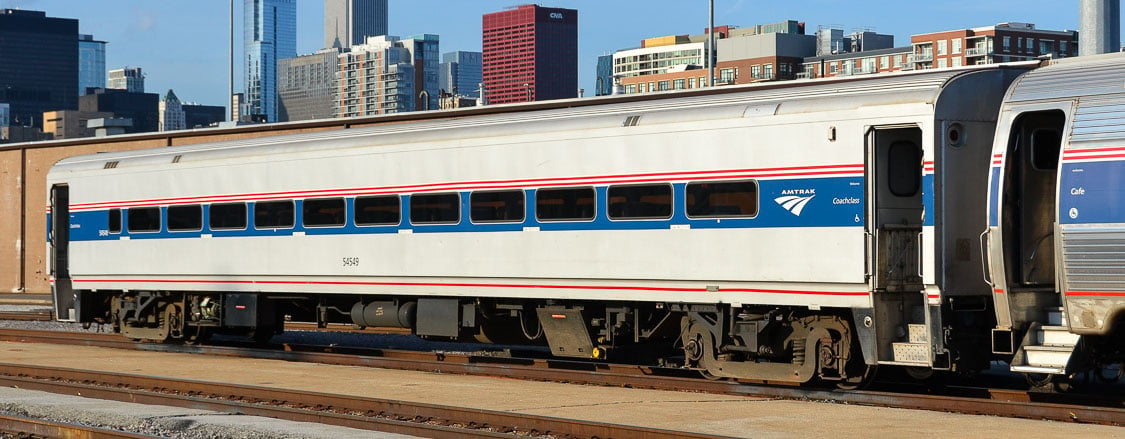
ADA-accessible coach 54549 is seen in the coach yard at Chicago, IL. Photo by Matt Donnelly, used with permission.
Amtrak California: 2013
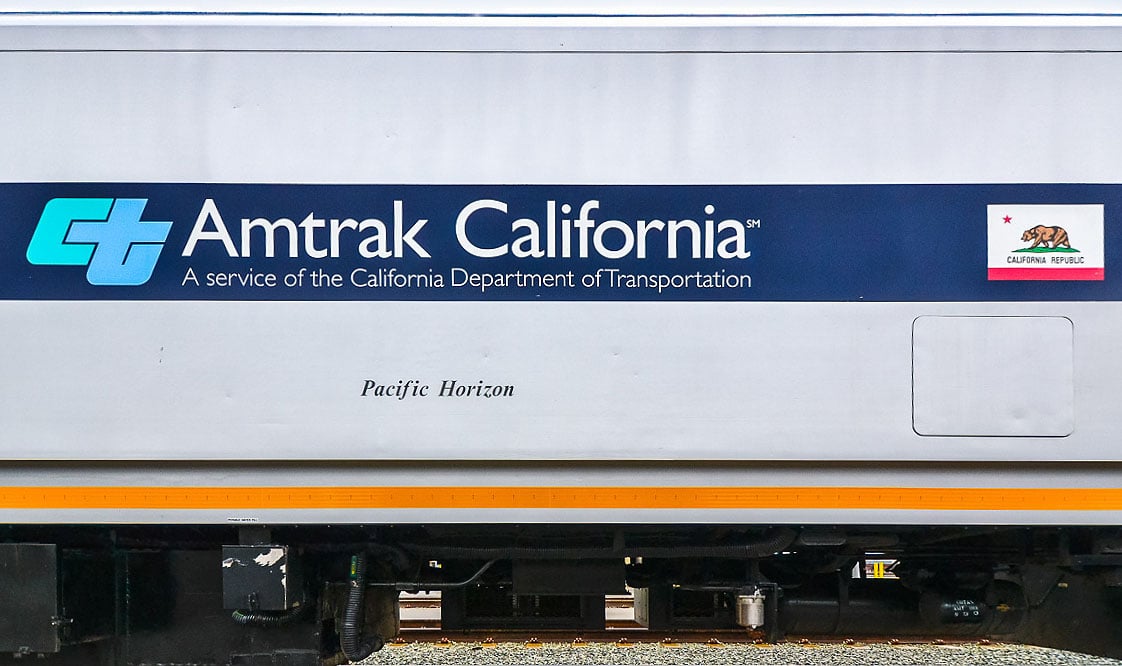
Dinette 53510 sports Amtrak California lettering, along with the CalTrans logo, California state flag, and a new name – Pacific Horizon. Photo by Matt Donnelly, used with permission.
Roster of As-Built and Rebuilt Horizon Cars
When the Horizon Fleet was built, the cars were delivered in a few basic configurations.
| Roadnumbers | Carbody Type | Seats | Configuration | Built | Notes |
|---|---|---|---|---|---|
| 53000-53007 | Dinette | 19 | Snack-coach | 1989-1990 | |
| 53500-53509 | Dinette | -- | Full diner (all tables) | 1989-1990 | |
| 54000-54043 | Coach | 82 | Standard coach | 1989-1990 | |
| 54044-54071 | Coach | 76 | Standard coach | 1989-1990 | Includes baggage area |
| 54500-54513 | Coach | 72 | Coach (ADA) | 1989-1990 | Accessible restroom |
Some years later, all of the non-ADA coaches were converted to be accessible. They were renumbered into the 54500-series to join the coaches that had been delivered in that configuration.
| New Numbers | Old Numbers | Seats | New Configuration | Date | Notes |
|---|---|---|---|---|---|
| 54514-54571 | 54014-54071 | 68 | Coach (ADA) | Unknown | |
| 54572 | 54011 | 68 | Coach (ADA) | Unknown | |
| 54573-54575 | 54001-54003 | 68 | Coach (ADA) | Unknown | |
| 54576 | 54013 | 68 | Coach (ADA) | Unknown | |
| 54577-54584 | 54005-54012 | 68 | Coach (ADA) | Unknown |
As Amtrak’s needs changed, some small groups of Horizon cars have been rebuilt or reconfigured for different types of service. Several coaches were converted with long-distance seating for use on the Three Rivers route, but were later restored to the typical ADA-compliant configuration. Meanwhile, the Club-Dinette cars serve today with half business class seating and half table seating, common on short distance corridor trains. They are usually arranged with the business class section at the far end of the consist, keeping foot traffic to a minimum for a more exclusive experience.
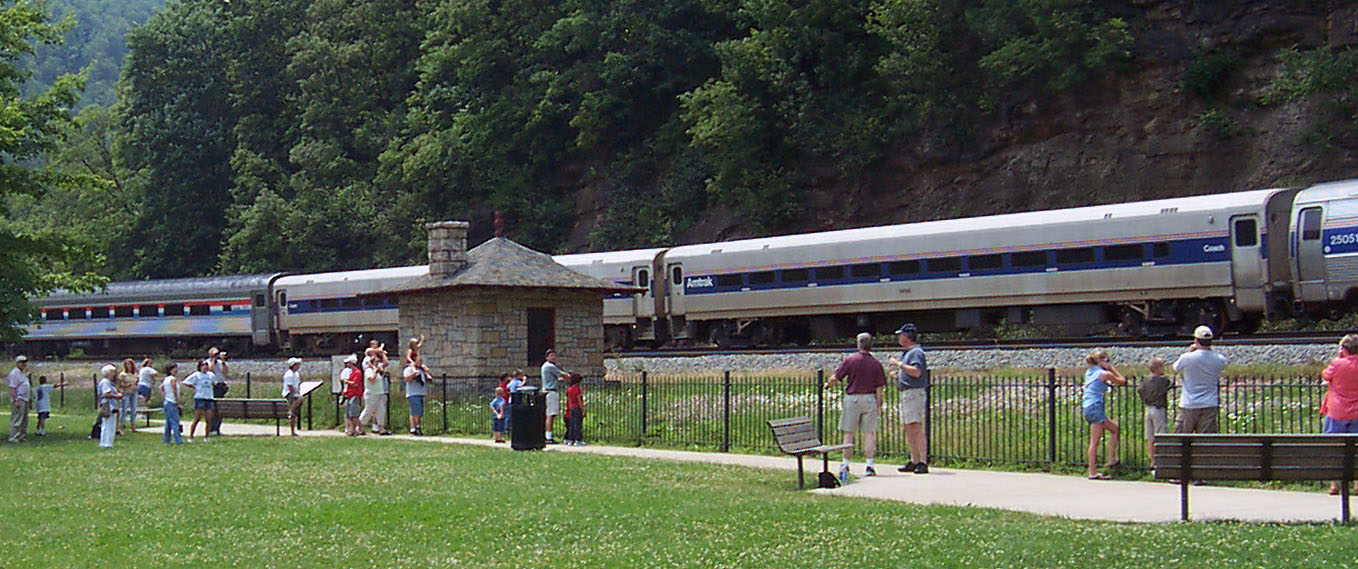
Two converted long-distance Horizon coaches are seen sporting Phase IV stripes as the Three Rivers winds through Horseshoe Curve. Note that the right-most car still has one of its original sliding doors and folding step traps. Photo by Alex Stroshane.
| New Numbers | Old Numbers | Seats | New Configuration | Date | Notes |
|---|---|---|---|---|---|
| 51000 | 54071 | 60 | Long-distance coach | 2001 | Rebuilt/renumbered again in 2008 |
| 51001 | 54046 | 60 | Long-distance coach | 2001 | Rebuilt/renumbered again in 2008 |
| 51002 | 54019 | 60 | Long-distance coach | 2001 | Rebuilt/renumbered again in 2008 |
| 51003 | 54060 | 60 | Long-distance coach | 2001 | Rebuilt/renumbered again in 2008 |
| 51500 | 54502 | 60 | Long-distance coach | 2001 | Rebuilt/renumbered again in 2008 |
| 51501 | 54570 | 60 | Long-distance coach | 2001 | Rebuilt/renumbered again in 2008 |
| 51502 | 54569 | 60 | Long-distance coach | 2001 | Rebuilt/renumbered again in 2008 |
| 51503 | 54559 | 60 | Long-distance coach | 2001 | Rebuilt/renumbered again in 2008 |
| 58000 | 53000 | 14 | Club-Dinette | 2004 | Rebuilt from snack-coach |
| 58002 | 53002 | 14 | Club-Dinette | 2004 | Rebuilt from snack-coach |
| 58004 | 53004 | 14 | Club-Dinette | 2004 | Rebuilt from snack-coach |
| 58006 | 53006 | 14 | Club-Dinette | 2004 | Rebuilt from snack-coach |
| 58007 | 53007 | 14 | Club-Dinette | 2004 | Rebuilt from snack-coach |
| 58100 | 53500 | 14 | Club-Dinette | 2005 | Rebuilt from full diner |
| 58103 | 53503 | 14 | Club-Dinette | 2005 | Rebuilt from full diner |
| 58104 | 53504 | 14 | Club-Dinette | 2005 | Rebuilt from full diner |
| 58106 | 53506 | 14 | Club-Dinette | 2005 | Rebuilt from full diner |
| 58107 | 53507 | 14 | Club-Dinette | 2005 | Rebuilt from full diner |
| 58108 | 53508 | 14 | Club-Dinette | 2005 | Rebuilt from full diner |
| 54502 | 51500 | 72 | Coach (ADA) | 2008 | Rebuilt from long-distance coach |
| 54519 | 51002 | 68 | Coach (ADA) | 2008 | Rebuilt from long-distance coach |
| 54546 | 51001 | 68 | Coach (ADA) | 2008 | Rebuilt from long-distance coach |
| 54559 | 51503 | 68 | Coach (ADA) | 2008 | Rebuilt from long-distance coach |
| 54560 | 51003 | 68 | Coach (ADA) | 2008 | Rebuilt from long-distance coach |
| 54569 | 51502 | 68 | Coach (ADA) | 2008 | Rebuilt from long-distance coach |
| 54570 | 51501 | 68 | Coach (ADA) | 2008 | Rebuilt from long-distance coach |
| 54571 | 51000 | 68 | Coach (ADA) | 2008 | Rebuilt from long-distance coach |
The three dinette cars leased to Amtrak California received “Horizon”-themed names, in addition to a new Amtrak California color scheme.
| Roadnumber | Type | Seats | Configuration | Built | Name |
|---|---|---|---|---|---|
| 51501 | Dinette | -- | Full diner (all tables) | 1989-1990 | Golden Horizon |
| 51509 | Dinette | -- | Full diner (all tables) | 1989-1990 | Pacific Horizon |
| 51510 | Dinette | -- | Full diner (all tables) | 1989-1990 | Western Horizon |
References:
Amtrak By the Numbers by David C. Warner and El Simon. White River Productions, 2011.
Amtrak By the Numbers: Updates On Track On Line.
Amtrak Rolling Stock Roster On Track On Line.
Updating Amtrak’s Current Rolling Stock Roster by El Simon. Passenger Train Journal, July 1990.
Amtrak’s Horizon Fleet cars by Bob Birkholz and Julian Cavalier. Railroad Model Craftsman, November 1992.
